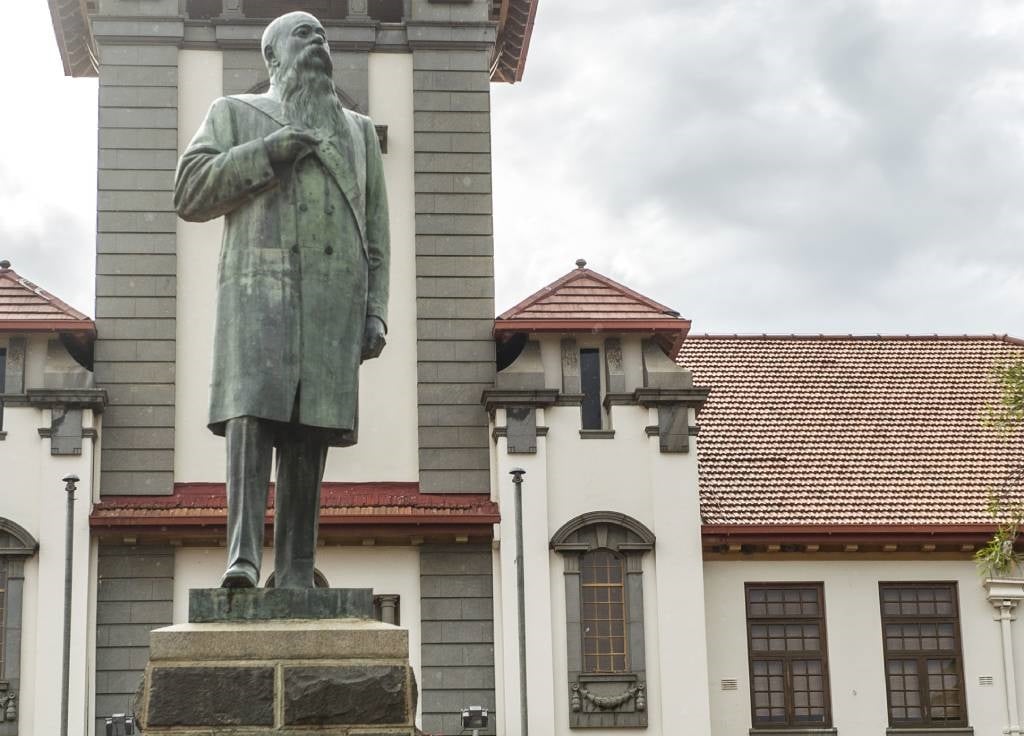
- Anglo-Boer war president Marthinus Theunis Steyn's statue was removed from the UFS campus over the weekend.
- The removal has been planned since 2018, but sparked widespread criticism.
- Here's why the university decided to remove the statue.
After years of planning, the statue of Orange Free State president Marthinus Theunis Steyn has been removed from in front of the University of Free State (UFS) main campus over the weekend.
Steyn was the sixth and last president of the then independent Orange Free State from 1896 to 1902, was an avid fighter against colonial rule, and was one of the founders of UFS.
UFS management said the removal occurred as they were granted a permit by the Permit Committee of the Free State Provincial Heritage Resources Authority (FSPHRA) to dismantle it in mid-June.
Despite the removal being approved by the university's council in 2018, it sparked widespread criticism with a number of UFS alumni remarking that they were permanently cutting ties with the university.
The removal was, however, welcomed by the student representative council (SRC) who said it was a move toward creating a more inclusive university.
The statue was erected through donations by the Afrikaanse Studentebond in 1929.
Here is why UFS quietly removed the statue of Steyn over the weekend:
Why does the statue of Steyn have to be removed?
Discussions around the repositioning and removal of the statue already started in 2003, and was again raised during a university assembly on 28 April, 2015.
During the past decade, the statue had repeatedly become the target of vandalism with students using it as a symbol to rally against during the Fees Must Fall movement.
UFS spokesperson Lacea Loader said the statue made the current student body feel unwelcome, as it "represents a period in history that they do not feel part of".
Anglo-Boer War Museum Director Tokkie Pretorius said Steyn's statue had lost context in front of the UFS main building, and instead of people understanding the man who helped found the university, he became associated with racism and exclusion.
"It would, therefore, be better to move the statue to a location where context can be created around who the man was, instead of him being politicised," Pretorius told News24.
SRC president Katleho Lecho said the statue reminded black students of a time where students of colour were excluded from the institution.
Lecho said Steyn was associated with a regime in South Africa's history founded on exclusion, and was therefore, by implication, representative of racism.
"The removal of the statue and symbol represents a victory for all UFS students as it didn't represent the current disputation, but instead reminded students of our oppressive past," Lecho told News24.
Why was it removed over the weekend?
Loader said after the FSPHRA issued a permit to the university on 11 June to dismantle, store and relocate the statue, a Conservation Management Plan was submitted which was approved on 17 June.
Arrangements were made shortly thereafter for the dismantling and storage of the statue.
The university has been engaging with Steyn's descendants since 2018 about the removal of the statue to ensure they're happy with the arrangements.
Advocate Colin Steyn, Steyn's great-grandchild, told News24 that one of the family's specific requests was that the removal take place without much fanfare, and he was, therefore, grateful that it took place during the lockdown when there weren't too many students on the campus.
"We didn't want a situation such as at the University of Cape Town where a spectacle was made over the removal of Cecil John Rhodes' statue. I didn't want my great-grandfather to experience that."
"I am also grateful that he was removed before there was any paint thrown on him or he was vandalised."
Where is the statue going, and what comes in its place?
UFS said an agreement was being finalised with the Anglo-Boer War Museum to relocate the statue there.
"The agreement should be concluded in the coming week and the statue can then be relocated to the museum," Professor Francis Petersen, Rector and Vice-Chancellor of the UFS, said.
The permit granted by FSPHRA stipulated that the university must prepare a plan and a team around the statue's removal, and appoint a heritage architect to oversee the process.
Pretorius said they're looking forward to housing the statue as, at the museum, context can be created around who Steyn was and the role he played, which was often lost on the university campus.
He said it was also symbolic that Steyn would be housed at the museum which also has the National Women's Monument, which Steyn advocated to be built.
Steyn's words, in Dutch, are engraved at the foot of the statue - the statue is in honour of all the women and children who suffered in British concentration camps during the Second Boer War.
At the monument are also the graves of Boer General Christiaan de Wet, Steyn, his wife, and the ashes of Boer humanitarian Emily Hobhouse.
Petersen said the space left behind by Steyn's statue in front of the UFS main building would be reinterpreted "into a symbolic, inclusive public space that advances nation-building and social cohesion".
Who was Steyn?
Steyn, born on 2 October 1857 in Winburg, outside Bloemfontein, was president of the Orange Free State from 1896 to 1902.
Steyn was educated at Grey College in Bloemfontein and at Deventer, Netherlands, and became state attorney and was appointed to the high court of the Orange Free State in 1889.
After winning the presidential election of February 1896, Steyn pursued a policy of economic independence and of protecting the Dutch language against English-speaking immigrant influences.
When British troops took Bloemfontein in March 1900, Steyn fought on as a guerrilla leader, and was unable to sign the formal surrender in Pretoria on 31 May 1902 due to poor health.
After the war, he worked hard to build the National Women's Memorial, the first monument in the world dedicated to women and children, together with his family friend Hobhouse.
He died on 28 November 1916 at the age of 58 in Bloemfontein.




 Publications
Publications
 Partners
Partners























